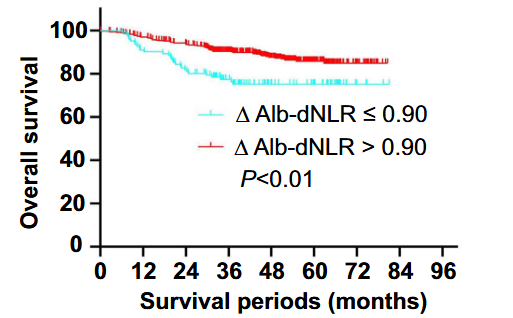The prognostic role of the change in albumin-derived neutrophil-to-lymphocyte ratio during neoadjuvant chemoradiotherapy in patients with locally advanced rectal cancer
DOI:
https://doi.org/10.17305/bb.2023.9787Keywords:
Albumin-derived neutrophil-to-lymphocyte ratio (Alb-dNLR), locally advanced rectal cancer (LARC), neoadjuvant chemoradiotherapy (nCRT), prognosisAbstract
The prognosis of patients with locally advanced rectal cancer (LARC) has improved with the adoption of a multidisciplinary treatment approach combining neoadjuvant chemoradiotherapy (nCRT) and total mesorectal excision (TME). Developing real-time, sensitive biomarkers to monitor systemic changes during nCRT is of paramount importance. Although the association between albumin-derived neutrophil-to-lymphocyte ratio (Alb-dNLR) and prognosis in various cancers is established, its prognostic value in LARC patients undergoing nCRT is not well-studied. This study enrolled a cohort of 618 LARC patients, stratifying them into two groups according to their change in Alb-dNLR (∆Alb-dNLR) values, using an optimal cut-off point: a low ∆Alb-dNLR group (≤ 0.90) and a high ∆Alb-dNLR group (> 0.90). The prognostic significance of ∆Alb-dNLR was evaluated using a Cox proportional hazards model. The 5-year overall survival (OS) rates were 75.2% in the low ∆Alb-dNLR group (≤ 0.90) and 85.9% in the high ∆Alb-dNLR group (>0.90) (P < 0.001). The 5-year disease-free survival (DFS) rates were 71.2% and 80.6%, respectively (P = 0.016). Multivariate analyses demonstrated that both ∆Alb-dNLR and pre-Alb-dNLR were independent prognostic factors for OS (P ≤ 0.001), while ∆Alb-dNLR was demonstrated as an independent prognostic factor for DFS (P = 0.016). A predictive nomogram, incorporating the ∆Alb-dNLR subgroup, demonstrated enhanced performance (concordance index [C-index] of 0.720 for OS and 0.690 for DFS) compared to the pre-treatment Alb-dNLR subgroup (C-index of 0.700 for OS and of 0.680 for DFS). Therefore, ∆Alb-dNLR shows significant potential as a usable and prognostic biomarker for predicting OS and DFS in LARC patients undergoing nCRT.
Citations
Downloads

Downloads
Published
Issue
Section
Categories
License
Copyright (c) 2023 Zhen Pan, Ye Wang, Shoufeng Li, Huajun Cai, Guoxian Guan

This work is licensed under a Creative Commons Attribution 4.0 International License.
How to Cite
Accepted 2023-10-12
Published 2024-05-02









